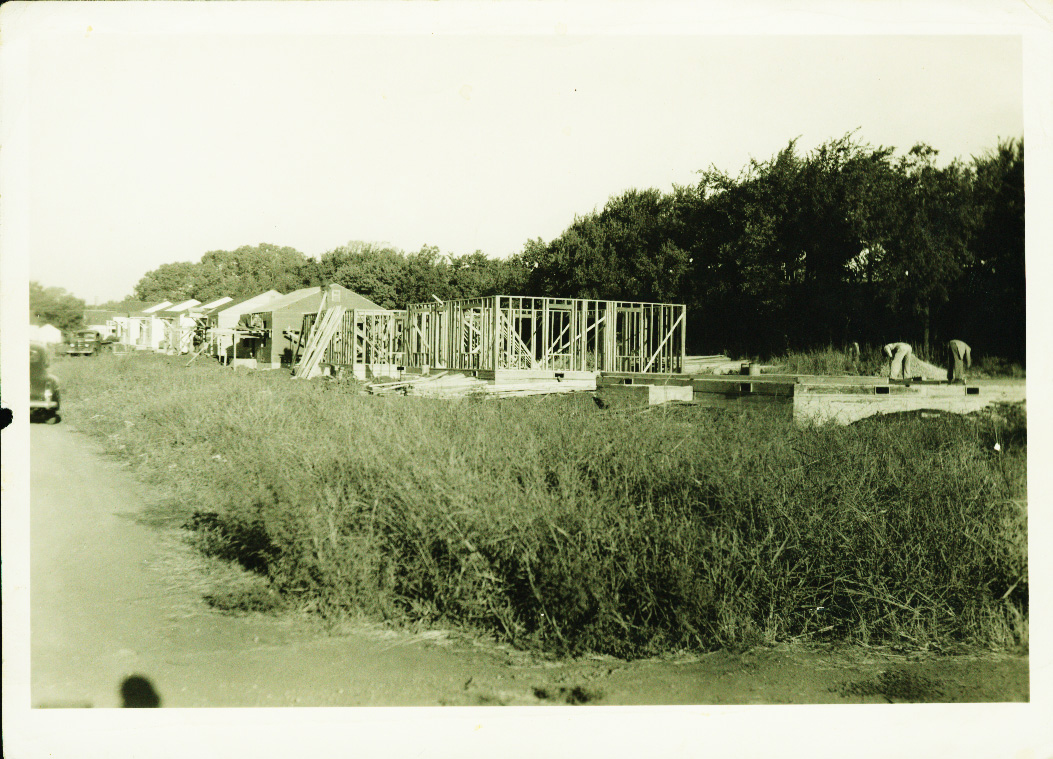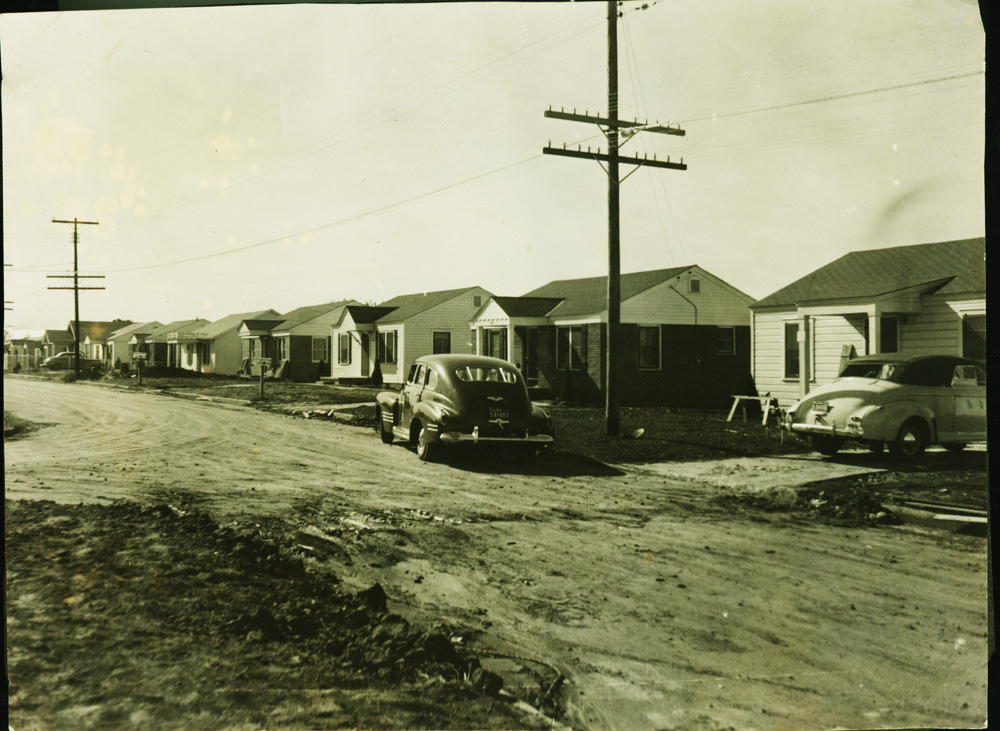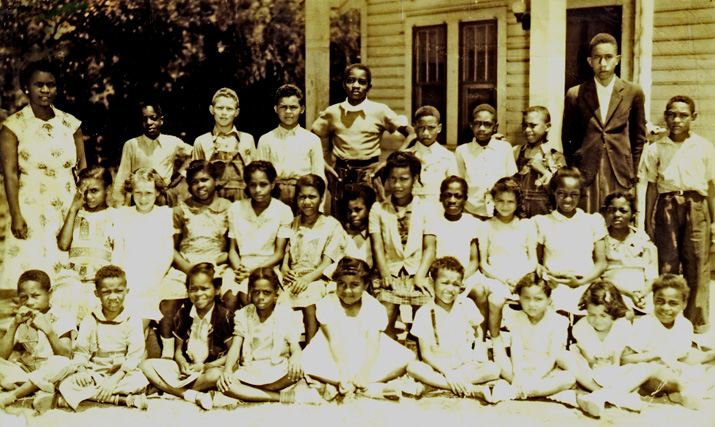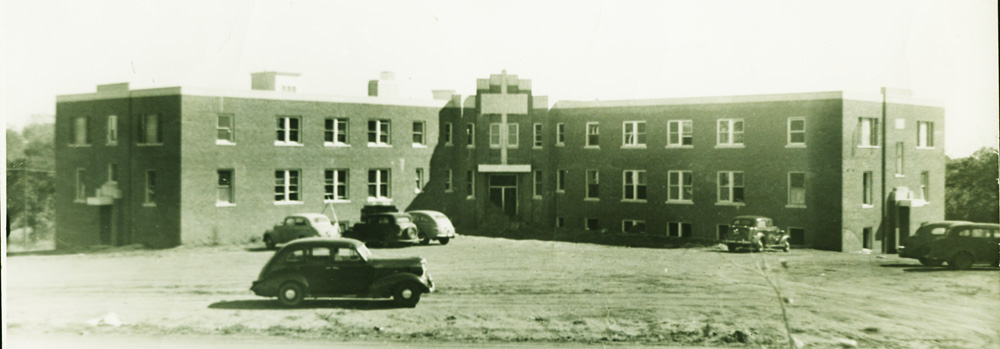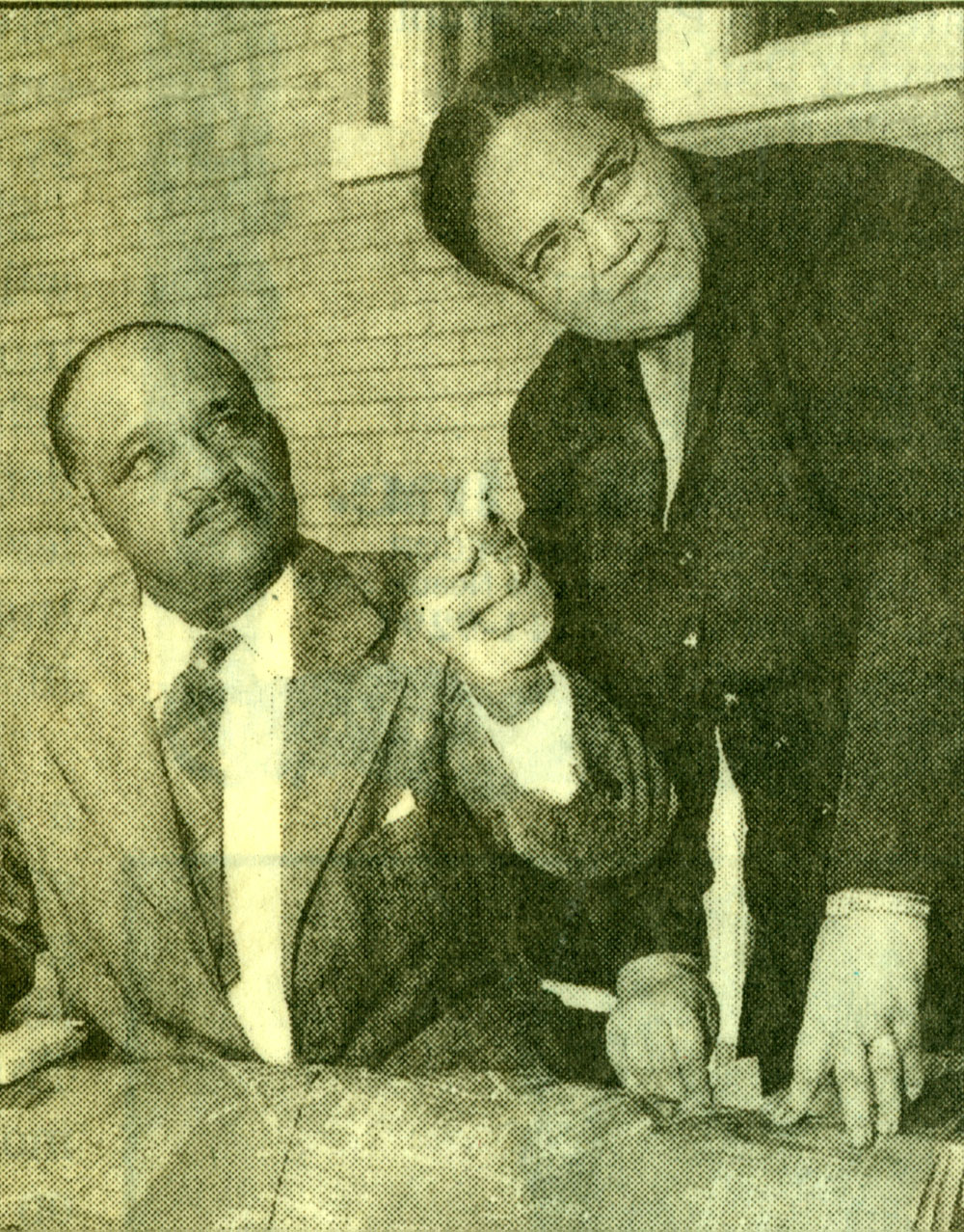
The Edwards Family and
BLACK ENTREPRENEURIAL SUCCESS
By Dr. Paul Lehman*
To many people living in Oklahoma City, the names Walter James and Frances Giliam Edwards mean very little; to others, they mean more than words could ever tell. The impact of the lives of Walter and Frances Edwards has been felt in Oklahoma City since the early 1930s, and will continue to be felt for many years to come.
For the Edwardses being black in American society during the days of de facto segregation and Jim Crowism posed a real challenge. The problems associated with segregation, racism, and discrimination plagued and followed them most of their lives, but these problems never defeated them. W. J., as he was called, was born in 1893 in Maston, Mississippi, but moved to Wellston, Oklahoma, in 1907. In 1915, at the age of twenty-two, he moved to Oklahoma City where he secured a job in a junk yard earning nine dollars a week. From his earnings, he was able to save some money and eventually start a baggage company with a horse and wagon. From this start in business he was able to branch out into a carpet-cleaning business and ice cream plant.
Although his education was limited-he never went beyond the fifth grade-his sights and aspirations were not. Once Oklahoma City began to acquire automobiles in fairly sizable numbers, W. J. built one of this city's first "drive in" filling stations, located at the time on Second and Stiles. Although W. J. would venture into other businesses, he rarely strayed too far from the junk business which he also owned. Lucky for him too, because the junk yard served as the foundation of his fortune. When the stock market crashed in 1929, W. J. went broke; he regained his wealth from the sale of scrap iron from his junk yard during World War II.
One of the most significant times in W. J.'s young life occurred in 1930 when he met Frances Waldrop. Edwards, it seems, could not keep up with every aspect of his businesses, so he hired Frances as his bookkeeper. He noticed a change for the better almost immediately. That same year, they were married.
The new Mrs. Edwards was born in 1898 in the state of South Carolina. She was one of eleven children; her father was a rural school teacher and brick mason. The educational and business experience she brought to the marriage helped to put the junk yard on a solid financial foundation. Working as a team, the Edwardses were able to realize considerable success from their business investments.
The Black Dispatch, on June 10, 1937, carried a story with headlines that read "Hassman Heights New Addition For Negro Citizens." The subtitle was "W. J. Edwards Starts Crews Clearing Ground For Home Sites." Taken together, both title and subtitle give the suggestion of some kind of arrangement between Hassman and Edwards. Kent Ruth, in a 1951 article in Today's Health explained it: "On the northeast edge of Oklahoma City the Edwardses found some rolling, semi-wooded land. They persuaded the owner to plat the area and get it approved by the city council for development before completing the transfer. 'We knew there might be a fight if we tried to get it platted after we bought,' Edwards explained." The property was a 33-acre tract of land extending north from N. E. 10th to N. E. 16th streets and roughly from Page Street to Grand Boulevard. The Edwardses purchased that property for $15,000 from C. T. Hassman of Tuttle, Oklahoma.
When the public announcement was made concerning the purchase of Hassman Heights by the Edwardses, Mrs. Edwards was quick to set minds at ease concerning the business of purchasing a house: "I spent nine years in the real estate business in Wichita Falls, and the game is nothing new to me. 1 suspect I am safe in saying that I sold seventy-five per cent of the homes owned by Negroes in that city."
Walter and Frances worked as a team to achieve their common goals. They had to. Being black in the late 1930s was not difficult if a person adhered to all the racial stereotypes associated with popular negative ideas, attitudes, and opinions. The free enterprise system in America had a few drawbacks if you happened to be black. In 1933, for example, the Oklahoma City city council passed an ordinance which defined parts of the city in which black people could live. After much work by black citizens, the ordinance was declared unconstitutional in 1936. The law changed, but the practice remained for a good many years afterwards. In any event, unless black business people had goods and/or services that were marketable outside the black established community, then black businesses were forced to stay within that confine.
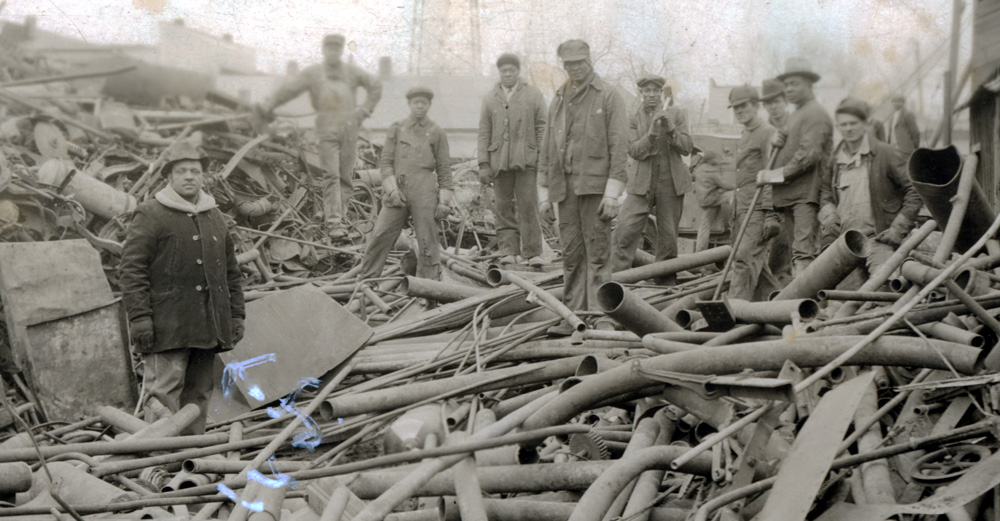 |
| W. J. Edwards (dark coat) in Junk Yard with Work Crew |
The Edwardses knew that little thought would be given to a white man seeking city council approval for a housing development; they also knew that a black man seeking the same thing would experience considerable difficulty. The general white public impression concerning the houses to be built by the Edwardses ranged from little to no concern. W. J. explained, "You see, the Negro always has to prove himself first. Once we started building and the whites saw the houses we were putting up, we didn't have any trouble."2
Trouble, however, plagued the efforts of the Edwardses in getting FHA financing. Stereotypical attitudes had to be confronted. For example, the FHA director in Oklahoma City, while seeing nothing wrong with their plans for building houses commented that "Negroes will never work hard enough, or save enough of what they do earn, to payoff the loans. I know; I've had them working for me."3
To this particular statement, W.J. replied that "perhaps my people have never had the right opportunity. We think they can do it."4 Nevertheless, before the Edwardses were successful in securing FHA financing, they "ran water, gas and sewer lines, paved streets and built three houses. . . ."5 The housing project received FHA authorization in 1939, the first FHA approved housing project ever received by blacks. The development of the Edwardses' addition represented not only an extraordinary venture by far-sighted and caring people, but it also represented a wealth of economic opportunities for black people at a higher level of life.
Before the Edwardses finished their housing developments, they constructed some 800 houses. These houses provided investment opportunities to blacks that the society at large had not. One FHA official was quoted at one time as saying to W. J. that his houses were worth much more than he was asking for them. The purchase plans of the houses included a low down payment and monthly installments of $16.45 to $24.00. Edwards concurred with the official's comments but added that given the circumstances, blacks could not afford to pay much more than the price he asked.
The experiences of actually constructing the houses provided many blacks in Oklahoma City with an opportunity to learn a trade or skill while they earned money. During this period, blacks were not encouraged to learn trades or skills; neither were they welcomed into the unions. Armed with this knowledge, W. J. in 1938 employed a white foreman and together they began hiring young blacks. The young workers were trained in areas such as bricklaying, carpentry, and electricity. The end result can be viewed even today in Oklahoma City where many of the young men who began with Edwards learned a trade and went into business on their own.
|
|
|
|
Homes in Edwards Addition (above) provided affordable housing to blacks and offered opportunities for black employment. |
|
To Edwards, if people were not provided the opportunity to experience ownership of home and property, they could not develop pride and enthusiasm in caring for their property. The houses constructed by blacks for blacks helped to provide just such an opportunity. As early as 1951, the Edwardses could boast that "no Edwards-built home has yet been repossessed for delinquent payments."6
Acquiring and maintaining a home for many blacks in Oklahoma City began a process that was passed from one generation to another. The result of home ownership on the children and adults was visible in the schools and churches. For example, in Edwards Addition, school absenteeism was very low as was the crime rate in comparison to other black communities. Children who grew up in a home environment usually learned the value of such an experience and sought to follow in the footsteps of their parents. For many blacks, this was the first time in their lives they were actually experiencing a piece of the "pie."
|
|
|
Early version of Edwards Elementary School (background) and its students. |
The Edwardses were able to secure additional financing from the FHA a year later. By 1951 they had developed or platted for development some 170 acres and constructed over 600 houses. Mrs. Edwards in 1937, the year the land was purchased, commented that "my husband and I do not intend to make a whole lot of money out of the transaction. We thought it would be a good investment, but at the same time we want the people to know that we plan to sell every lot in the addition at a reasonable price and at terms that any person with a job and a sincere desire to own a home can pay for ."7
The perseverance of the Edwardses in building their housing project not only improved the quality of life for black Oklahoma Cityans but for all of Oklahoma City. With the building of the houses came a demand for many new goods and services. Most of those goods and services had to come from outside the black community. The end result was a substantial economic plus for Oklahoma City. This venture was quite an accomplishment for two black people living in a segregated society where the free enterprise system was neither free nor color blind.
Although the housing addition occupied the focus of their attention during the late 1930s, that development was not the only business investment interest in the black community made by the Edwardses. Some of their other interests included two filling stations, the Blue Bird Taxi Cab Line, an auto garage, investments in several pharmacies, and a carpet cleaning plant. In addition, they donated land for a public school and park. They were instrumental in making possible land purchase for a church in the addition at a reasonable price.
The biggest investment of the Edwardses' lives came in 1945. In that year the black population of Oklahoma City numbered around 30,000. The health facilities for blacks, however, were inadequate. Eighty-nine segregated hospital beds were all 30,000 black Oklahoma Cityans had for their services. And these beds were located in the hospital's basements.
Unfortunately, Mrs. Edwards became critically ill in 1945 and had to be taken to the hospital. She was placed in the crowded basement ward with five other patients. During her brief stay there, her condition did not improve. Finally, her doctors one day called W. J. out into the corridor where they informed him of his wife's unimproved condition. They advised him that what his wife needed to get well was proper hospitalization and rest in a pleasant environment.
|
|
|
Edwards Hospital during final construction phase - one of the Civic Contributions made by the Edwards family |
The Edwardses were forced to deal with a problem. They were wealthy, but money meant absolutely nothing in a Jim Crow or segregated hospital. They decided on two things. First, they would go to the Mayo Clinic at Rochester, Minnesota. There with the proper medical treatment Mrs. Edwards could regain her health. Second, when Mrs. Edwards regained her health and returned to Oklahoma City, they would attempt to provide the citizens of Oklahoma City, black and white, with a modern hospital.
On April 17, 1948, a radio dramatization of the story of the Edwardses as black American entrepreneurs was beamed over the "Voice of America" in an effort to counteract Communist propaganda that American blacks did not enjoy free enterprise. The message was broadcast with the ltalian people in mind because they were in the middle of an election that could have easily been turned in the direction of the Communists. The dramatization of the Edwardses, nonetheless, marked a first for black people in America.8
On April 18, 1948, still another first was made by the Edwardses. President Harry Truman broke a long-standing rule against sending personal congratulatory messages when he wrote to the Edwardses that:
You Mr. Edwards and Mrs. Edwards, as chief donors, and the other generous citizens who joined in founding this hospital have made a real contribution to human welfare. lt is in accord with our American ideals that humanitarian efforts such as this should be the work of many hands. Best of all the benefits of the hospital will be extended without consideration of racial or religious affiliations. I congratulate you and all the others who have made possible this noble institution. I trust that through long years to come the hospital will be of service to the people of Oklahoma.9
Edwards Memorial Hospital was no ordinary hospital. It offered opportunities for the training of black doctors, nurses, and other medical support personnel. One story of note associated directly with the hospital concerns Dr. and Mrs. Charles Atkins.10 Mrs. Hannah Atkins commented that it was through an article published in a national magazine in 1950 that featured a story on the Edwardses and their hospital that encouraged her and her husband to move to Oklahoma City. Dr. Charles Atkins did his general residency at Edwards Memorial Hospital in 1951 and 1952.
The lack of training and practicing opportunities for blacks in the medical profession was the primary reason for shortages of qualified personnel. In 1951 the hospital staff was comprised of 26 white and 13 black doctors; together, they represented the only interracial staff in the South. Three stories tall, the hospital included two operating rooms, a delivery ward, an eye, ear and throat clinic, an X-ray room, a laboratory, pediatric ward, physical therapy room, and a diet kitchen.
"The Edwards Story," by Kent Ruth provides a fitting summary of the achievements of the Edwardses. Ruth said of them in 1951 that:
Unspoken yet implied in all the tribute paid the Edwards is one simple truth: the Edwards story proves that race is not a factor in determining the qualities of character that produce success. Vision, ambition, humanitarianism, the capacity for hard work, honest labor. . . all are necessary for truly successful living. The Edwards have all of them in generous proportions. 11
|
|
|
W.J. and Frances Edwards - Envisioning Community Development |
That was in 1951. In 1986 the hospital no longer existed as a tribute to the love and concern for humanity that its founders built into it. Changing times and attitudes helped to close the hospital, but changing times and attitudes did not destroy the legacy the Edwardses left behind.12 The accomplishments of W. J. and Frances Edwards, black entrepreneurs, Oklahomans, are the stuff of which history and role models are made. Their influence will be felt for years to come because they cared not just for blacks, but .for all people. What they accomplished helped make Oklahoma City a better place for people to live. The Edwardses, like the black poet Langston Hughes, could sing "(We) Too Sing America," but they could go the poet one better; they could sing "Oklahoma" and did so extremely well.
ENDNOTES
*Dr. Paul Lehman is is a university professor in the department of English, and a former Dean of the Graduate College, at the University of Central Oklahoma, Edmond, Oklahoma.
Acknowledgements and Permissions: The Edwards Family and BLACK ENTREPRENEURIAL SUCCESS by Dr. Paul Lehman originally appeared in The Chronicles of Oklahoma, Volume LXIV, Number 4, Winter 1986-87 (Pages 88-97)
Both the author (Dr. Lehman) and the original publisher (Oklahoma Historical Society) have granted permission to reprint this article on this website. Our thanks are extended to Dr. Paul Lehman of UCO and Dr. Dianna Everett, Editor and Publications Director of the Oklahoma Historical Society.
All photos were provided by Mrs. Deborah Bonner (deceased) and Mrs. A. Maxine Johnson, daughters of W.J. Edwards.
1 "Hassman Heights New Addition For Negro Citizens," The Black Dispatch, June 10,1937, p.8.
2 Kent Ruth, "The Edwards Story," Today's Health, February 1951, p. 2.1.
3 Ruth, p. 21.
4 Ruth, p. 21.
5 Ruth, p. 58.
6 Ruth, p. 58.
7 "Hassman Heights New Addition For Negro Citizens," p. 8.
8 This program entitled "Creed, Color, and Cooperation" was broadcast in Oklahoma City over radio station WKY. The reporter was Kenneth Johnson, a black World War II veteran. The radio program was the "Voice of the U.S.A."
9 "Negro Couple Put $400,000 Of Own Funds In Modern 105-Bed Health Center For All Races," The Black Dispatch, April 24, 1948, p. 1.
10 Dr. Charles and Mrs. Hannah D. Atkins are prominent citizens of Oklahoma City. Dr. Atkins was one of the first blacks to serve on the City Council of Oklahoma City; his wife, Mrs. Hannah D. Atkins was the first black female to serve as State Representative. Both are very active in civic activities in the city, state, and nation.
11 Ruth, p. 59.
12 Mrs. Frances W. Edwards died in 1958; Walter J. Edwards died in 1971.
